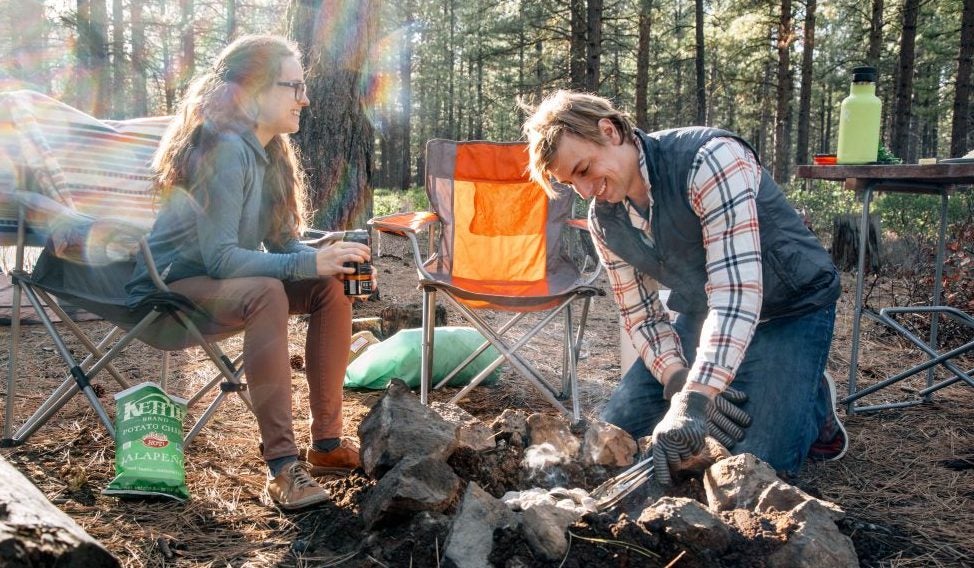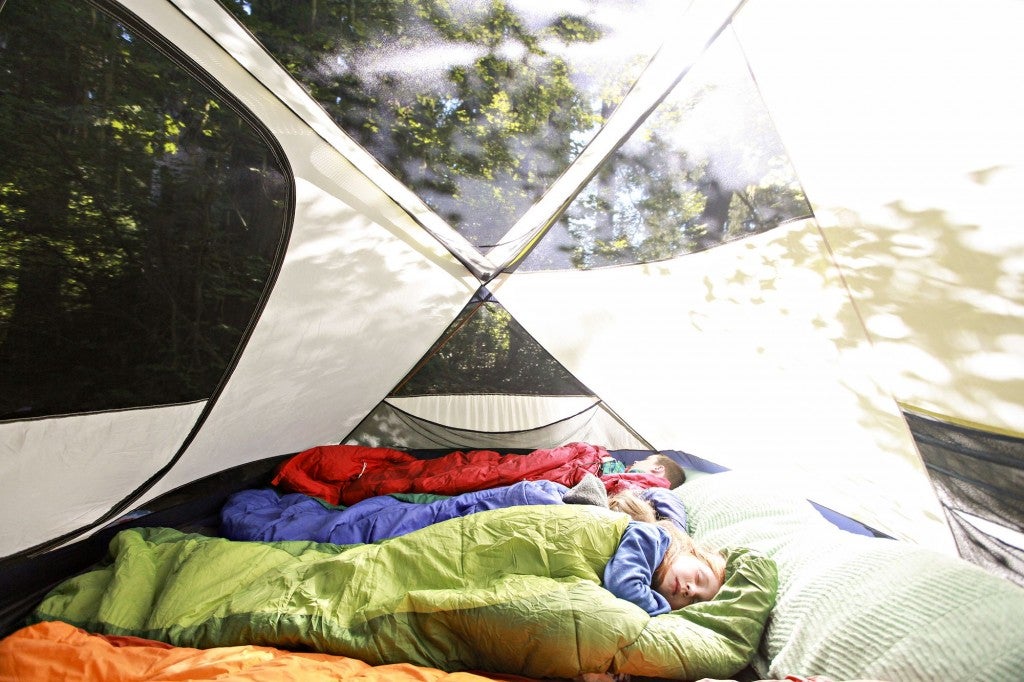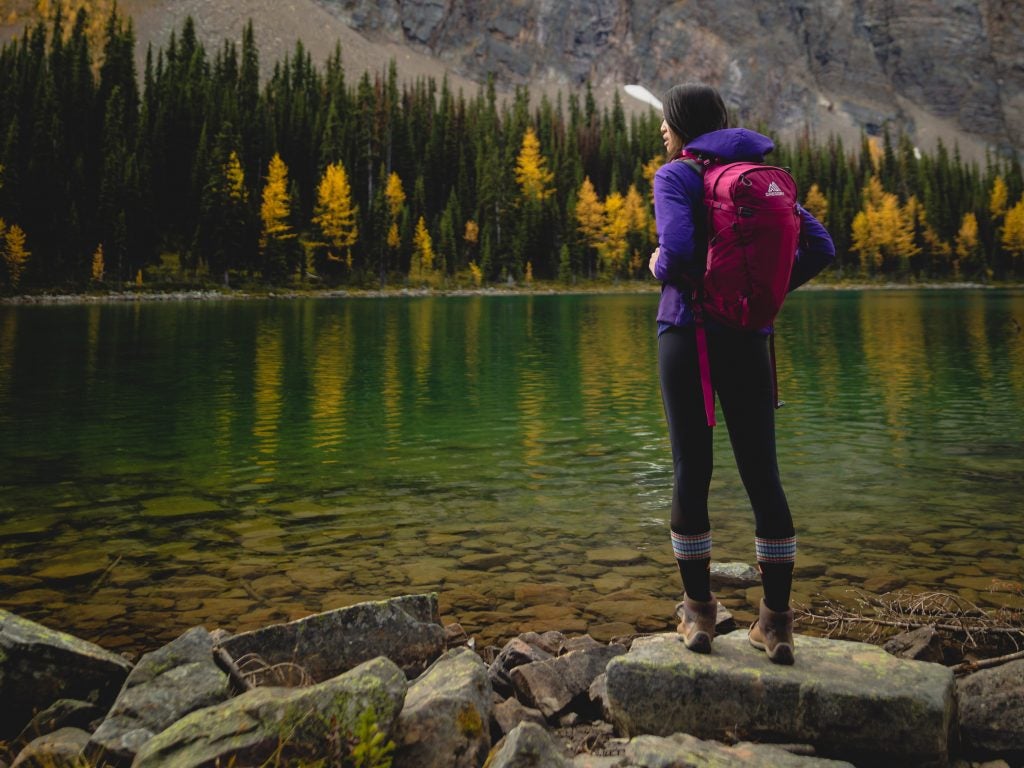One glance at the Fresh Off the Grid Instagram account, and you’ll be drooling. Megan and Michael, the dynamic foodies behind FOTG, craft noteworthy camp meals–most with minimal prep and little clean-up. Because who wants to spend time doing dishes when you could be roasting another marshmallow, instead?
We heard about Fresh Off the Grid from humangear, who recently partnered with Megan and Michael to test out the GoToob+, their new silicone travel bottle, among other products.
While exploring near and far from their home in Bend, OR, they’re not only testing food recipes, but drink recipes as well, like Campfire Mulled Wine and Canchanchara. Their website has nearly 200 recipes for camping, backpacking, and snacks for hiking.
We caught up with foodies Megan and Michael for a peek behind the scenes of Fresh Off the Grid.
Do either of you have “day jobs”?
Fresh Off the Grid is our full time gig! We spent our 20’s working in the corporate world – Megan in finance & administration at a non-profit and Michael in marketing at an outdoor apparel company. We tucked away as much of our paychecks as we could during those years and were able to leave those jobs to travel and build up our own business. Now, between our website, photography, and videography work, we have been able to completely replace our old “day jobs.”
How often are you camping?
At this point, we are weekend warriors. After spending over a year traveling and camping full-time, we decided to slow down and we settled in Bend, OR.
We’ve found that having a home base from which we can go on adventures feels much more sustainable for both our business and for us, personally. Luckily, Bend is a great jumping off point for weekend adventures. There is SO much to do within a couple hour’s drive!
You’re at a campground and it’s windy and pouring rain. Cooking dinner just isn’t going to happen. What’s the go to, prep-free tent food for days when foodies lose steam?
We nearly always camp with a can of chickpeas and a few packages of Trader Joe’s Indian Fare for just this scenario! You can dump the chickpeas and a package of dal or curried vegetables into a pot to quickly heat, or it can be eaten cold (though on cold rainy nights, we argue that a warm meal is worth at least some effort!).
If you have some tofu or pre-cooked chicken with you, that can be thrown in as well, along with vegetables that can be enjoyed raw like spinach, bell peppers, or carrots. If you have a package of pitas on hand, then you have a full meal with almost zero prep and only one dish to clean at the end of it all.
[bctt tweet=”Between our website, photography, and videography work we have been able to completely replace our old “day jobs.” ” username=”FreshOffTheGrid”]
What does your dish cleaning setup look like when you’re preparing a big meal at camp?
First things first: there’s a difference between clean and camping clean. There is an official three bucket method (we use collapsible buckets) for properly rinsing, washing, and sanitizing dishes in the frontcountry that has been developed by Leave No Trace. If we’re cooking for a big group, we follow that method.
If we are cooking for ourselves, the three bucket method gets stripped down to a one bucket method – which is mostly just a soak & rinse in hot water with some biodegradable soap. The phrase “clean enough” is used pretty frequently between the two of us!
Is a camping cookbook on the horizon for other foodies?
We would love to write a cookbook! We’re toying around with a few different concepts we’d be really excited to move forward with. We just need to find the time to dive in!
What items can you not live without in your camp kitchen?
Our most versatile piece of equipment, hands down, is our cast iron skillet. It’s great on either a camp stove or over an open fire, and the high walls make it great for all sorts of one pot meals.
Because we spend a lot of time dispersed camping (opposed to camping at established campgrounds with lots of facilities), we’ve begun to bring a portable grill on many of our trips. We find that it minimizes the impact of cooking over a fire in areas that are a bit more sensitive than big campgrounds.
Finally, a “real” chef’s knife is one of our must haves. We usually bring the same knife that we use at home – no reason to switch to a duller, sub-par knife because you’re out in the woods!
What does your backcountry “spice cabinet” look like?
We love taking along spice blends instead of individual spices – they make it so easy to transform an entire dish. Our favorites are tandoori, ras el hanout, Thai red curry powder, and taco or fajita seasonings. If you spend a little time in your grocer’s spice section you’re sure to find something interesting!
BBQ or camp stove? Which one, and why?
Camp stove. Living in the West, you never know when a burn ban will get put into effect. At this point, wildfire season seems to start in March and run through November, so it’s definitely something we have to take into consideration.
A propane camp stove is just way more versatile. And if we really want those grill marks, we can always break out the cast iron griddle/grill and place it over the burners.
We live in an era of fast-paced, “I want it, and I want it now,” culture. Cooking, especially camp cooking, can be enjoyed at a more leisurely pace. What’s your favorite meal that’s more time intensive?
We have recently started experimenting with dehydrating meals, specifically for the backcountry. It’s easy to think the only way to eat while backpacking is to rely on prepackaged, freeze-dried meals. But dehydrating your own backpacking meals allows you a lot more control and versatility.
[bctt tweet=”There’s nothing wrong with starting off with just-add-water pancake mix or making hamburgers and hot dogs for dinner.” username=”FreshOffTheGrid”]
The process requires a fair bit of foresight and delayed gratification (dehydrating a meal can take up to 8 hours), but the payoff is immense. We recently developed a Dehydrated Mushroom Risotto that would be impossible to make in the backcountry were we to try and prepare it from scratch. By dehydrating it beforehand, we can enjoy rich, creamy, and insanely delicious risotto just by adding it to boiling water for 5 minutes.
It’s the last day of your camping trip and all you have left is an onion, three Field Roast hot dogs, a cooked ear of corn, and a carton of yogurt. What do you make?
Yogurt “creamed corn” alongside grilled Field Roast hot dogs topped with caramelized onions.
What recipe would you recommend for non-foodies at camp who say they “burn cereal”?
For novice camp chefs, we’d recommend sticking with the basics. There’s nothing wrong with starting off with just-add-water pancake mix or making hamburgers and hot dogs for dinner. Until you’re comfortable in the camping environment, and familiar with your cooking equipment, by all means, take some short cuts!
But for those looking to transition to the next steps, we have a few suggestions.
For breakfast, go with a simple veggie hash or breakfast sandwich like our Avocado Bacon Breakfast Sandwich. For dinner, you can’t go wrong with marinated meat and veggies over a grill. Tacos are hard to screw up and don’t rely too heavily on any one ingredient.
How often are you creating your own recipes? And is it a team effort?
We’re developing recipes all the time. Sometimes they’re adapted from meals we’re making at home, or a campsite-friendly version of a meal we’ve recently tried at a restaurant, and sometimes we’ll come up with a recipe for a specific piece of equipment (e.g. Dutch oven) or a seasonal ingredient (spring: asparagus, summer: peaches, fall: apples).
It’s a fairly collaborative effort, although we do have our own particular strong suits. Michael is better at breakfasts, lunches, and cocktails, Megan does really well at dinners.
Finally, which of you two camp foodies is more likely to burn dinner?
Megan is super distractible and will readily admit that she’s usually the culprit for a toasty dinner!
The Dyrt is the only camping app with all of the public and private campgrounds, RV parks, and free camping locations in the United States. Download now for iOS and Android.
Popular Articles:
Articles on The Dyrt Magazine may contain links to affiliate websites. The Dyrt receives an affiliate commission for any purchases made by using such links at no additional cost to you the consumer.



